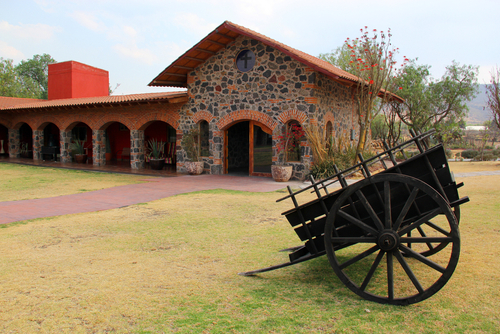From vibrant colours to intricate architectural details, Mexico’s traditional homes are a testament to its rich cultural heritage. This blog will take you on a captivating visual and historical tour through the most iconic types of Mexican homes, giving you an in-depth understanding of their design, history, and symbolism.
Whether you’re a design enthusiast, history buff, or just someone who appreciates the beauty of diversity, this guide will feed your curiosity about traditional Mexican architecture and cultural storytelling through space and form.
Mexican Traditional Homes Overview
Mexico’s cultural diversity is reflected brilliantly in its homes. Influences from indigenous traditions, Spanish colonisation, and modern adaptations combine to create homes that are both historic and functional. Many traditional homes were built to adapt to Mexico’s varied geography and climate, offering ingenious solutions for cooling, ventilation, and shelter.
We’ll examine some of the most prominent styles of Mexican homes, including haciendas, adobe residences, and vibrant colonial houses, offering insight into their unique traits and purposes.
Hacienda Style Homes
Origins of the Hacienda
Haciendas, rooted deeply in Mexico’s history, were large estates established during the Spanish colonial period. These homes served both as private residences and productive estates, often tied to agriculture or mining.
Key Architectural Features
- Courtyards: Central courtyards (patios) were essential for ventilation, offering open space and serenity for residents.
- Materials: Built from locally available materials like adobe, stone, and tiles, hacienda homes were designed to naturally regulate temperatures.
- Arched Doorways and raw wood beams added elegance and functionality.
Modern Appeal
Today, hacienda-style homes are popular for their timeless aesthetic, often inspiring contemporary luxury homes. Many restored haciendas now also serve as boutique hotels, allowing visitors to experience history firsthand.
Adobe Homes
Environmentally Adaptable Design
Adobe homes hold a special place in Mexico’s architectural history. These homes, designed with clay, sand, and water, have been used for centuries due to their energy efficiency and sustainable appeal.
Features
- Natural Insulation: Adobe homes are excellent for maintaining a consistent indoor temperature, keeping homes cool in summer and warm in winter.
- Charming Simplicity: These homes have a minimalist aesthetic, characterised by earthy tones and a strong connection to nature.
Though traditional adobe homes may appear rustic, their sustainability and resourcefulness have brought them back into focus for environmentally conscious architects.
Colonial Style Homes
Vibrant Legacy of the Spanish Colonists
The colourful colonial homes are perhaps among Mexico’s most recognisable traditional buildings. These homes were influenced by Spanish architecture, merging European elements with local artistry.
Features of Colonial Homes
- Bright Colours: Painted facades in bold colors like teal, terracotta, and ochre make colonial homes iconic and joyful.
- Ornate Tiles and Ironwork featured elegant craftsmanship, combining function with art.
- Stucco Walls provided durability and charm.
These homes are perfect examples of Mexico’s ability to celebrate tradition while inviting a sense of joy and individuality through architecture.
Palapas and Beach Homes
Perfect for Coastal Living
Found along Mexico’s beautiful beaches, palapas are traditional open-air structures with thatched roofs made of palm leaves. These homes are designed for coastal climates, providing shade and airflow.
Features
- Simplicity meets practicality with an emphasis on outdoor living.
- Roofs made from natural materials are eco-friendly and sustainable.
Palapas offer the ultimate laid-back, tropical living experience and are now a popular inspiration for beach clubs and luxury resort design.
Modern Influence with Traditional Roots
While these historic styles remain revered, contemporary Mexican homes often blend modern architecture with traditional aesthetics. Clean lines mix daringly with rustic stonework, and smart home technology is seamlessly integrated into cultural nods. From city homes in modern Mexico City suburbs to rural cottages, this balance reminds us that tradition and innovation can coexist beautifully.
FAQ Section
What are the most common architectural styles in Mexico?
The most common architectural styles include hacienda-style homes, colonial-style homes, adobe houses, and palapas along the coast.
Are traditional Mexican homes environmentally friendly?
Yes, many traditional homes like adobe houses and palapas are built using sustainable, natural materials. They are also energy-efficient, making them environmentally friendly.
Can I stay in a traditional Mexican house?
Absolutely! Many restored haciendas, colonial homes, and even eco-friendly palapas operate as boutique hotels or vacation rentals across Mexico.
What makes Mexican homes so vibrant in color?
The vibrant colors reflect Mexico’s artistic culture and love for individuality. These colours serve practical purposes, like keeping homes cool or protecting against the weather.
How have modern homes in Mexico incorporated traditional designs?
Modern homes in Mexico often mix clean, contemporary designs with elements like courtyards, rustic stonework, and vibrant colour schemes inspired by traditional architecture.
Discover the Stories Behind Mexico’s Homes
The rich history and vibrant culture found in Mexico’s traditional homes are nothing short of fascinating. Each home tells a story, merges artistic traditions, and reveals the ingenious ways people adapted to their environment.
Want to learn more about global heritage homes, unique lifestyles, or tips for creating your own cultural-inspired interior design? Subscribe to our newsletter today for expert insights and curated updates!
